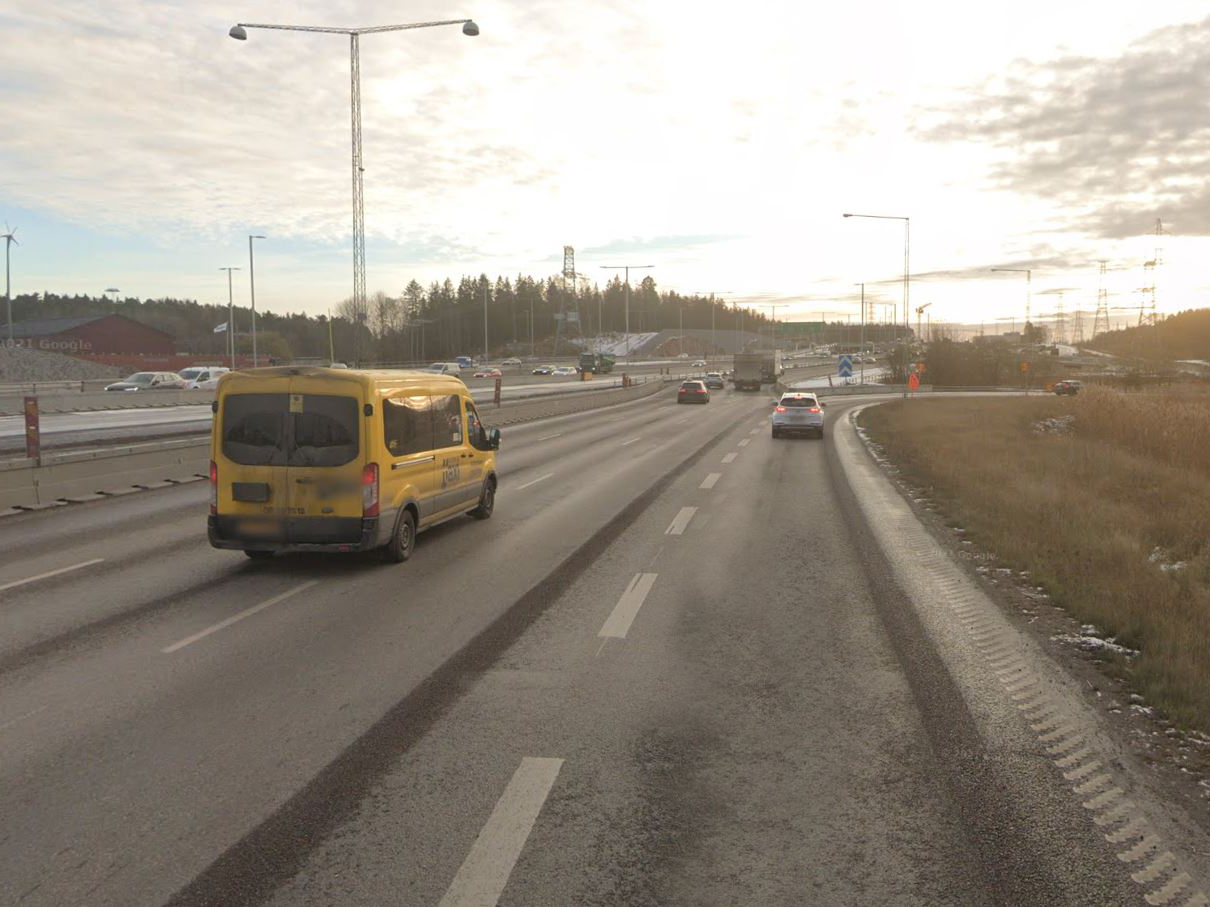Overview
A motorway is a large piece of road, usually with multiple lanes in one direction. The direction of traffic is usually split with either a barrier such as a ditch, fence, wall, railing, trees, etc
Motorway road sign
Consider the following when you see a motorway sign
- Traffic is always separated. Thus no U-Turn (U-turn can only be preformed over bridges or areas specially indicated)
- Intersections are usually not on the same level. Cars will drive over bridges and use entry and exit ramps to drive off of the motorway towards different directions
- Exit and entry ramps is apart of the motorway. Thus the same rules apply to them as what apply to a motorway
- Right lane is considered the slow lane and left lane is considered the fast lane. Always stay in the right lane and over take on the left
 Motorway (E1)
Motorway (E1)Entry ramps (Acceleration lane) onto a motorway
Consider the following image
 Gold car is entering the motorway from a entry ramp (Acceleration lane)
Gold car is entering the motorway from a entry ramp (Acceleration lane)- If Entry ramp exist (Acceleration lane exist): No one has priority on the entry ramp or the motorway. Mutual consideration should be given (Meaning you must adapt your speed to facilitate the car comming in or if your on the entry ramp you need to be considerate towards the cars on the motorway)
- If No Entry ramp exist (No acceleration lane exist): Anyone entering the motorway with no acceleration lane should give way to all traffic on the motorway
- Always adapt your speed to the motor way (Motorway speedlimit signs are place before each entry of the motorway)
- Plan ahead and be in the correct gear before you go onto the motorway
- Turn on indicators inadvance and check blind spot before entering
- Dont enter the motorway and cross over multiple lanes. You may only change one lane at a time
Driving on the motorway
Consider the following when driving on the motorway
- Keep the flow of traffic. Maintain the speedlimit but adapt to the traffic situation
- Overtake from the left
- Right lane is used to drive onto and out off the motorway. Its also used to drive slower, where the left most lane is used to overtake and drive faster
- Keep good safety margin distance to the traffic infront of you
- When a traffic queus forms, keep good distance between the cars infront of you as rear end collisions is common in head-to-tail traffic congestions
Exit ramp (Deceleration lane)
Consider the following scenario
 The white car is on the exit ramp (Deceleration lane)
The white car is on the exit ramp (Deceleration lane)- Prepare in advance to exit the motorway
- Use indicators to to indicate you will turn onto the exit ramp
- Only once you are on the exit ramp (deceleration lane) are you allowed to reduce your speed. (The instructor will test you on this in the practical test)
- Reduce your speed according to the road sign that will follow for the exit ramp (Usually it is 50km/h)
- The yellow vehicle is trying to cross multiple lanes to use the exit ramp (This should be avoided as crossing multiple lanes at once is not permitted and his time to enter the exit ramp is very narrow)
The following road sign indicates the exit ramp. This road sign is place at each exit from the motorway
 Exit plate (X4)
Exit plate (X4)What is not permitted on a motorway
- Stop and park.
- Make a U turn (Special areas exist for emergency vehicles to turn around). You need to make use of the bridges to make a U-Turn
- Reverse
- hitchhike
- Walk
- EU Moped
- Cycle
- Drive on the hardshoulder for any other reason that is not an emergency (Eg: towing another vehicle, Flat tyre, etc)
- Tow
- Vehicles that cant drive faster then 40 km/h (EU Moped can drive 45 km/h, but they are also not permitted on the highway)
- Tractor or heavy equipment (Exception: class I heavy equipment can be driven if is a mobile crane)
Risk on the motorway
Motorways are designed and built to reduce risk at high speed. However there is still somerisk to be aware of
- Velocitization after exit (This is when you drove for a long time and become unaware of your true speed. Thus it might feel slow when you turn off of the exit ramp but actually you are still driving very fast
- Keeping correct distance between the cars in front of you (Major accidents occur when cars on the motorway drive into each other)
- Single vehicle accident that result from prolonged tedious driving. You loose concentration and drive into a post or off from the motorway
- Wet motorways can get slippery very quickly when it starts to rain. Aquaplaning will increase due to the high speed and oil and dirt on the highway
